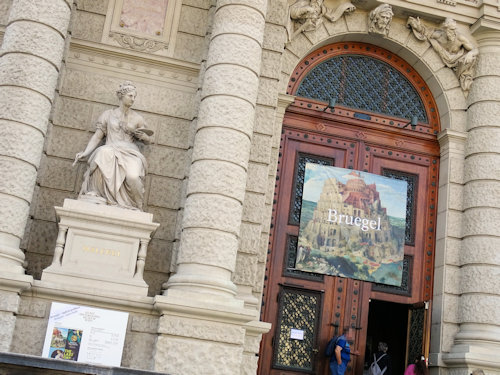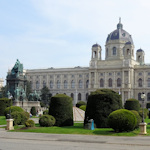Vienna’s famous Kunsthistorisches Museum (KHM) tends not to have the kind of rapid turnover of exhibitions you get from an Albertina or Belvedere. Partly, I’m sure, because the permanent displays are so rich and comprehensive.
However, the temporary exhibitions held each year seem to always fall into one of two categories: “small and special” or “major and magnificent”.
Below I’ve listed past exhibitions that I visited and/or wrote about, so you can develop a feel for what to expect from this prestigious art museum in the future.
- See also:
Old Masters

(The 2018/2019 Bruegel exhibition proved enormously popular)
Raphael: Gold & Silk
A monumental exhibition in the true meaning of the term, given the focus on huge Renaissance tapestries. Not just any tapestries but some of history’s most prestigious…including one of the originals famously produced for Pope Leo X and the Sistine Chapel in the early 1500s.
Raphael delivered the designs for that Vatican series, and his work set new standards for the medium. In addition to tapestries, the Gold & Silk exhibition also included related items such as several drawings by Raphael (ended January 2024).
Idols & Rivals
A slight change of direction in 2022 produced a rather lovely exhibition taking a more narrative approach to the presentation of great art.
Idols & Rivals explored artistic competition and collaboration across the ages and in various forms. So we had works placed together within the context of a historical tale or anecdote. Enlightening and entertaining in one (ended January, 2023).
Titian’s Vision of Women
The year 2021 saw the Old Masters exhibitions return with a bang. Or an espresso in this case, given the subject: Titian and other Venetian greats of Italian renaissance painting.
The Titian exhibition largely focused on the depiction of women in his art and works by contemporaries such as Tintoretto, Veronese, and Bordone (ended January, 2022).
Caravaggio & Bernini
2019’s end-of-year extravaganza brought together over 70 works from late 16th and early 17th century Rome: a first for a museum outside of Italy. The displays included several Caravaggio paintings and Bernini sculptures (the latter’s Medusa being a particular highlight).
The Caravaggio exhibition didn’t quite scale the heights of popularity of 2018’s Bruegel equivalent but provided intriguing insights into the groundbreaking world of early baroque Italian art (ended January, 2020).
Pieter Bruegel the Elder
One of the best and most popular events in recent Viennese museum history: the Bruegel exhibition featured around 75% of his surviving works, thus offering a once-in-a-lifetime Bruegel experience.
The Kunsthistorisches Museum already owns the world’s largest collection of Bruegel paintings (thanks to the Habsburgs) and the loans enabled themed works to be displayed with each other for the first time in centuries. I believe the appropriate technical term was….awesome (ended January, 2019).
Other major exhibitions
Georg Baselitz
The Baselitz exhibition saw this giant of contemporary art enter the paintings galleries at the museum and place his works in dialogue with those of the Old Masters.
So you had visual similarities and counterpoints, but also the shared experience: modern works that both reflect and break with the past. The paradox of a continuum and reinvention in one. And the juxtaposition forced the viewer to look at older works in a new compositional light (ended June, 2023).
Iron Men
A chance to see armour through a different light. Not as functional items of wear but as fashion statements, symbolic representations of power, and opportunities for creative expression.
As well as highlighting the artistic side of renaissance armour design, the Iron Men exhibition also cleared up a few myths about such things as movability when encased in steel (ended June, 2022).
Higher Powers
Summer 2021 seemed an auspicious time for an exhibition on how humanity views the elements that control our lives: God(s), fate, luck, Karma, public health requirements…etc.
The Higher Powers exhibition covered various beliefs through history and across societies and civilisations. Items from the extensive collections of the wider museum group and contributions from the public provided illustrative physical manifestations of these beliefs (ended August, 2021).
Mark Rothko
A little foray into modern art for the Kunsthistorisches Museum, with the Rothko exhibition featuring over 40 of his works. The connection to the earlier art you associate more with the KHM comes from the sources that inspired Rothko. He travelled extensively to the great historical centres of European art and drew on mythology and religious iconography.
The exhibition included the famous Seagram Mural Studies that (perhaps fortuitously) never appeared in the restaurant setting they were first intended for (ended June, 2019).
Beethoven Moves
Poor old Ludwig had a whole year of citywide celebrations to look forward to for his 250th birthday. But 2020 had other plans for us all, so the exhibition suffered from unavoidable delays and fewer visitors than it deserved.
Beethoven Moves juxtaposed historical and contemporary art with Beethoven-related material to illustrate how he inspired and influenced others and continues to do so in the 21st century (ended January, 2021).
Spitzmaus Mummy in a Coffin
An unusual title for an eclectic exhibition curated by none other than Wes Anderson and Juman Malouf, who picked out their favourites from the museum’s large and diverse collections. The Spitzmaus of the title is a mummified shrew from the Egyptian department (ended April, 2019).
Ansichtssache
(Small exhibitions that present one or two works alongside some new or special insight.)
Colour in Black and White
Ansichtssache #26 offered an informative presentation of the techniques and technologies behind the photographic documentation of the paintings collection way back in 1888-1891 (ended May, 2023).
Salvator Mundi
Ansichtssache #25 revealed the craft and history behind Titian’s Christ with an Orb painting with its particular version of the Salvator Mundi motif (ended October, 2022).
Who was FH?
Ansichtssache #24 looked at two Dürer-inspired altar panel paintings and the detective story behind analysis of their 16th-century provenance (ended November, 2021).
Head of Medusa by Rubens
Ansichtssache #23 compared two paintings of the Head of Medusa by Peter Paul Rubens, one from the museum’s own collection and the other a loan from Brno’s Moravian Gallery; one on canvas, the other on oak (ended March, 2019).
Coin Collection
Around the World in 80 Coins
Another intriguing exhibition in the coin collection that presented sixteen historical travellers (from the Greek princess Olympias to Soliman the elephant). A selection of coins from the relevant era accompanied each short biography, along with information on how those coins reveal something about a time and place in world history (ended January, 2024).
Evil Emperors
A fascinating little exhibition that featured brief biographies of numerous Roman Emperors. Each biography included a selection of coins to illustrate how the manipulation of objects, images and narratives clouds objectivity and colours our understanding of people and histories (ended March, 2022).
Other exhibitions
In Love with Laura
Perhaps one of those mysteries wrapped in an enigma. A rare coloured Renaissance bust by Francesco Laurana formed the core of this exhibition, but the other displays explored the possibility that the woman might be the fabled Laura, subject of numerous 14th-century love poems by Petrarch. Fascinating! (Ended October, 2023.)
Cranach the Untamed
An intriguing exhibition that presented the rare early works of Lucas Cranach the Elder from his stay in 16th-century Vienna. The works show an unexpected expressiveness when compared with the better-known paintings from his time at the court of the Elector of Saxony (ended October, 2022).
Jan van Eyck
This small exhibition paid hommage to another pioneer of European painting, with a triple treat of van Eyck works: the 1439 Madonna and Child at the Fountain, the 1436 portrait of Jan de Leeuw, and the 1435 (ish) Portrait of a Scholar. Misattributed and related works completed the displays (ended January, 2020).
